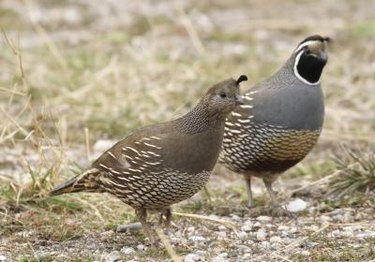Whether you're raising quail for eggs, meat, or just for ornamental beauty, it's not difficult to tell adult male quail apart in most quail breeds. Males have deeper coloration on their breasts, faces, and heads than females, and they usually also have a different call.

Coturnix male quail look rusty
Coturnix quail are some of the smallest of popular quail breeds and, with comparatively little smell or sound, are appropriate to raise indoors in a rabbit cage or reptile aquarium. The females lay eggs nearly every day, and they can be processed for meat at 9 weeks old, making them one of the most profitable quail to keep.
Video of the Day
Video of the Day
Unlike many quail species, Coturnix can look nearly identical at first glance. However, they're easily identifiable as soon as their breast and facial feathers come in. Although both female and male quail are speckled, males have a darker background that is rust-colored. Females' feathers tend toward a light buff or sand tone.
Male and female Coturnix also sound different. Females are nearly silent, making quiet little peeps. Males make a trilling sound that usually isn't loud enough to disturb anyone in the neighboring apartment.
Native quail breeds
If you're raising outdoor quail as game birds, you might choose one of several types of species that are native to North America. The birds are typically raised for meat, hunting, or as ornamental additions to the homestead. Unlike Coturnix, these native breeds typically take 6 months or more to mature and lay only about 200 eggs per year.
Native quail are popular with homesteaders wishing to raise quail outdoors. Besides taking longer to mature, many require special accommodations to prevent them from hurting themselves when they take flight, or hand-feeding for the first few months of life. Depending on which state you reside in, you might need a permit to raise them.
Look for colors
Female quail are generally less dramatically colored than the males in breeds native to North America. The markings found on native breeds will let you know which is male or female. In the Gambel quail found in the desert Southwest, the male has a dark chestnut cap on his head, black face, chestnut wings, a cream belly, and a grey patch on his chest. The female is uniformly grey, with no black mask or bright cap.
The California quail looks similar to the Gambel but the male doesn't have a belly patch. Other North American quail include the bobwhite, mountain quail, and Montezuma quail. Males of each of these quail breeds have a dramatic mask lined in either black and white (bobwhite and Montezuma) or chestnut and white (mountain quail), making it easy to tell a male quail at a glance even if no female is present.
It's harder to tell the difference between scaled quail, as both males and females are bluish-grey without a distinct face mask. However, the male of the species has a cream-colored throat; the female's throat is light brown.
Check the plume
Several types of North American quail sport head plumes that make them a visually striking addition to your homestead or aviary. Gambel quail, mountain quail, and California quail males and females all have topknot feathers.
Males of each species always have the most dramatic head plumage at maturity. Although the female has this feathering on her crown, it is much smaller. In quail breeds where plumed males and females look similar, such as mountain quail, you might need to refer back to the more demure brown tones of the female or the more dramatic male mask to positively identify the bird's gender.
- YouTube: Coturnix Quail Crowing
- The Happy Chicken Coop: 5 of The Most Common Quail Breeds for Homesteaders and Which is Right for You
- The Cornell Lab: Gambel Quail
- The Cornell Lab: New World Quail
- Washington Department of Fish and Wildlife: Quail Hunting
- Texas A&M Agrilife Extension: Scaled Quail
- Mother Earth News: Keeping Quails — Gender Differentiation